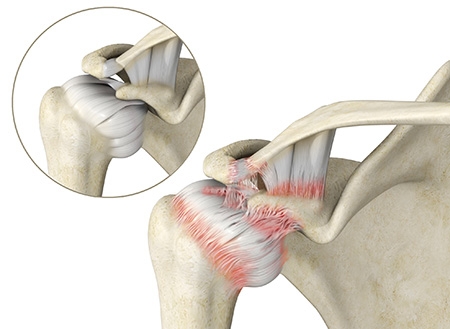We are all accustomed to a certain degree of soreness and stiffness here and there, especially as we age. Sometimes soreness and stiffness is just that and resolves with rest, stretching, ice, and maybe some over-the-counter anti-inflammatory medications. However, soreness and stiffness could be something more. That something more is called adhesive capsulitis or more commonly, 'frozen shoulder.'
Adhesive capsulitis is a condition that typically develops over time and progressively worsens. It is characterized by stiffness, discomfort, and limited mobility. Risk factors that increase your risk of developing this condition include diabetes, thyroid issues, middle-aged female gender, and recent injury or illness that hinders your ability to move your arm for any length of time. The etiology of this condition involves the tissues that comprise the joint capsule becoming thickened and restrictive; thus, causing pain and preventing motion. Frozen shoulder is often described using three stages: freezing (often the most painful stage as motion decreases), frozen (the most restrictive phase), and thawing (symptoms are found to be improving).
Diagnosing adhesive capsulitis starts with an x-ray to rule out other pathologies such as arthritis, which can also cause pain and limit mobility. The physical examination will then give your physician the information needed to make the diagnosis. An examination of the shoulder involves assessing the range of motion the joint will allow. A patient who does not have a frozen shoulder can actively move his or her shoulder a certain amount, and then the physician can typically push the shoulder a bit further through different ranges of motion and identify what we call a 'soft' end feel. A frozen shoulder, however, can be moved in a very limited fashion by both the patient AND the physician.
The mainstay of treatment for those afflicted by adhesive capsulitis is aggressive formal physical therapy to improve the range of motion of the joint. For patients struggling with significant pain in addition to the stiffness, a cortisone injection directed into the shoulder joint may be provided as well. In severe cases, a course of oral steroids may be prescribed, though the side effects of this potent medication often deter physicians from including it in the regimen. Most patients who are diligent with the physical therapy exercises do well with this conservative treatment plan.
Regardless of whether or not formal treatment is provided, the symptoms related to adhesive capsulitis will most often resolve on their own with time, but it could take a year or two. However, if debilitating symptoms persist despite conservative management, your physician may offer to perform a surgical joint manipulation with or without debridement. This involves the patient being put under general anesthetic so the surgeon can move the joint past what would be comfortable if the patient were awake. This helps loosen the capsule. This alone is not invasive (no incision necessary). However, your surgeon may recommend arthroscopically cleaning out scar tissue in the joint to allow it to move better. This is known as debridement. It is often coupled with a manipulation procedure.
If you’ve been dealing with a stiff and sore shoulder, call the friendly folks at Orthopaedic Associates of Wisconsin today to schedule a consultation at any of our three convenient clinic locations!
This blog is written by one of our very own-Morgan. She is a certified athletic trainer working in our clinic with our providers each and every day. She obtained a bachelor's degree in athletic training from Carroll University in Waukesha and a master's degree in Kinesiology from Michigan State University.

